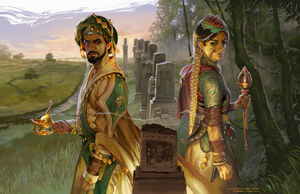
Ivory Kingdoms
The Ivory Kingdoms consisted of a collection of smaller principalities, from where fleets had arrived and eventually attacked the Emerald Empire. [1]
Contact with Rokugan
It was known that the Mantis Clan had reached its coasts. [2] The local tongue was known as Ivindi, [3] which was also the Rokugani term to identify elements belonging or relating from this place. [4] The Ki-Rin's Road connected the Kingdoms with Khanbulak, a Rokugani city of the Unicorn Clan. [5]
Politics
The Ivory Kingdoms were a sprawling, shifting mosaic of monarchies, religious territories, and city-states united under the rule of the maharaja. In reality, this ever-changing patchwork of political entities, mostly payed only lip service to the maharaja's rule. The result was a long history of strife. Various ethnic, cultural, and religious groups rose to great power and prominence. [6] There were five Ivory Kingdoms factions that have risen in prominence: the ruling Sheelavaan, the Mukka religious sect, the Saamrajya monarchy, the Tajir traders, and the Naga serpent folk. Each faction has their own seat of power, ranging from the City of Splendor, Bhavyatapura, to the delta of the Heeratand. [7]
Geography
Located south and west of Rokugan, the Ivory Kingdoms were broadly defined by an expanse of gently rolling plains, bordered on three sides by the ocean, a massive mountain range to the north, and by thick, swampy forests to the northeast. The fertile plains gave way to salt flats, which themselves dwindled into the rocky barren wastelands and desert of the Burning Sands. The central interior of the Ivory Kingdoms was dominated by the Sonagiri or “Golden Mountain,” until it ended at a mountain range that dominated the center of the Ivory Kingdoms region. Shaktimaan Deevaar, the Mighty Wall, was the impenetrable mountain range that marked the northern border. The northeast was low-lying and poorly drained, with a warmer and wetter climate, which resulted in a lush expanse of thick, tangled rainforest, the Ghostlands, that separated the Ivory Kingdoms from the southernmost reaches of the Shadowlands. South of the Ghostlands, on the Ivory Kingdoms’ eastern coast, a great river irrigated the land of a host of independent cities and villages, many of which were rich with trading partners from foreign lands. The southern tip of the Ivory Kingdoms was a great swampy delta, sheltered on one side by a small mountain range and on the other by a thick mangrove forest, where the naga folk were most numerous. The rich and fertile soil in and around the forest that lined the western coast and wide south-flowing river was the place where many kingdoms have built themselves up. The Himapaat, or Snow River, the Heeratand, and the Nadati were the most important rivers of the Ivory Kingdoms. [8] The Haunted Jungles, one of the two subregions commonly recognized as existing in the Deep Shadowlands [9] bordered the Ivory Kingdoms. [10]
Climate
Climate varied greatly across the Ivory Kingdoms. Warmer and wetter weather prevailed in the south and east, with a drier and cooler climate on north and west. The southern Kingdoms were generally tropical: hot and muggy through most of the year, and particularly wet during the monsoon season in the summer and autumn, with frequent, drenching rain-storms rolling in from the ocean. Away from the ocean, the amount of rainfall diminished. The northern border was the point at which rainfall became so scarce that no crops could be reliably grown. [11]
Religion

Ivory Kingdoms inhabitants
The Ivindi temples used to have an amalaka, a notched stone disk, on its top. [12]
Pantheon
This is a list of the known gods of the Ivory Kingdoms:
Known Schools
History
Purple Horde
During Shinjo's journey the Ivory Kingdoms were visited by the Purple Horde. [13]
References
- ↑ Smokeless Fire, by Katrina Ostrander
- ↑ Legend of the Five Rings: Roleplaying Game (Beta), p. 104
- ↑ The Mantis Clan
- ↑ Dark Tides, p. 26
- ↑ Emerald Empire: The Essential Guide to Rokugan, p. 77
- ↑ Path of Waves, p. 196
- ↑ Cite error: Invalid
<ref>tag; no text was provided for refs namedTIK - ↑ Path of Waves, p. 197
- ↑ Shadowlands: The Essential Guide to the Dominion of Fu Leng, p. 13
- ↑ Mask of the Oni, p. 10
- ↑ Path of Waves, p. 198
- ↑ Emerald Empire: The Essential Guide to Rokugan, p. 84
- ↑ Across the Burning Sands, by Daniel Lovat Clark
| This article is a stub. That means that it has been started, but is incomplete. You can help by adding to the information here. |